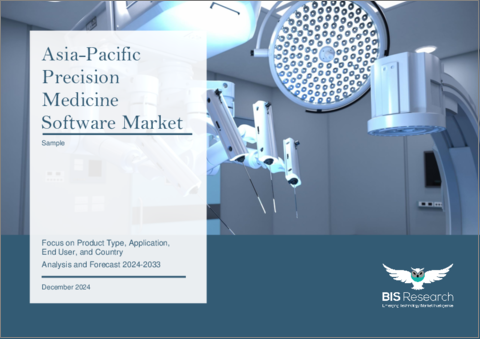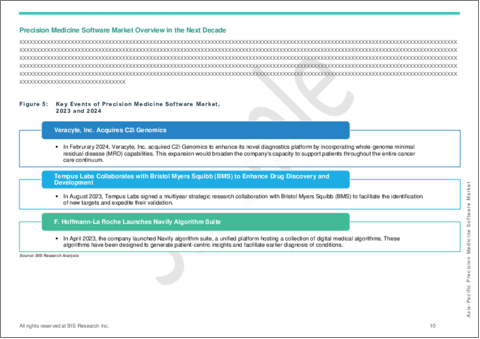|
|
市場調査レポート
商品コード
1614805
アジア太平洋の精密医療ソフトウェア市場:製品タイプ・用途・エンドユーザー・国別の分析・予測 (2024-2033年)Asia-Pacific Precision Medicine Software Market: Focus on Product Type, Application, End User, and Country - Analysis and Forecast 2024-2033 |
||||||
カスタマイズ可能
|
|||||||
| アジア太平洋の精密医療ソフトウェア市場:製品タイプ・用途・エンドユーザー・国別の分析・予測 (2024-2033年) |
|
出版日: 2024年12月17日
発行: BIS Research
ページ情報: 英文 51 Pages
納期: 1~5営業日
|
全表示
- 概要
- 図表
- 目次
アジア太平洋地域の精密医療ソフトウェアの市場規模は、2023年の3億840万米ドルから、予測期間中は13.74%のCAGRで推移し、2033年には11億1,080万米ドルの規模に達すると予測されています。
| 主要市場統計 | |
|---|---|
| 予測期間 | 2024-2033年 |
| 2024年評価 | 3億4,860万米ドル |
| 2033年予測 | 11億1,080万米ドル |
| CAGR | 13.74% |
アジアの精密医療ソフトウェア市場は、個別化医療ソリューションの利用の拡大やデジタルヘルス技術の開発により急成長しています。患者の予後を向上させる個別化治療計画を作成するため、精密医療ソフトウェアは、遺伝的要因、ライフスタイル、環境要因を含む膨大な量の患者データを評価・解釈するように作られています。この手法は、オーダーメイドのケアが不可欠な遺伝性疾患、癌、慢性疾患の治療に特に有効です。
医療インフラ投資の増加、個別化医療を奨励する政府プログラム、バイオテクノロジー分野の発展などの追い風を受け、韓国、中国、日本、インドなどの国が市場をリードしています。精密産業におけるより効果的なデータ処理と意思決定は、AI、機械学習、ビッグデータ解析の技術開発によって可能となっています。
複雑なデータを処理し、実用的な洞察を提供できる革新的なソフトウェアソリューションは、個別化治療やゲノミクスの進歩に対する需要の高まりにより、ますます必要性が高まっています。精密医療ソフトウェアの拡大は、同地域で電子カルテ (EHR) の利用が増加し、ヘルスケアのデジタル化が進んでいることも後押ししています。
精密医療ソフトウェアは、同地域の医療環境がさらに発展する中で、治療の精度を向上させ、患者中心の治療を促進する上で重要な役割を果たすと考えられており、地域全体の医療成果の向上に貢献しています。
市場の分類:
セグメント1:提供形態別
- オンプレミス
- クラウドベース
セグメント2:用途別
- 癌
- 心血管
- 希少疾患
- その他
セグメント3:エンドユーザー別
- ヘルスケアプロバイダー
- 研究センター・政府機関
- 製薬・バイオテクノロジー企業
- その他
セグメント4:地域別
- アジア太平洋
- 日本
- インド
- 中国
- 韓国
- オーストラリア
- その他
当レポートでは、アジア太平洋の精密医療ソフトウェアの市場を調査し、業界の動向、技術・特許の動向、法規制環境、市場成長促進要因・抑制要因、市場規模の推移・予測、各種区分・主要国別の詳細分析、競合情勢、主要企業のプロファイルなどをまとめています。
目次
エグゼクティブサマリー
範囲と定義
第1章 市場
- 動向:現在および将来の影響評価
- 個別化医療の台頭
- クラウドベースのデリバリープラットフォームによるデータアクセシビリティの向上
- サプライチェーンの概要
- バリューチェーン分析
- 研究開発レビュー
- 特許出願動向
- 規制状況
- 市場力学の概要
- 市場促進要因
- 市場抑制要因
- 市場機会
第2章 地域
- 地域別概要
- 成長推進因子・抑制因子
- アジア太平洋
- 地域概要
- 市場成長の原動力
- 市場課題
- 用途
- 製品
- 中国
- インド
- オーストラリア
- 日本
- 韓国
- その他
第3章 市場:競合ベンチマーキングと企業プロファイル
- 次なるフロンティア
- 地理的評価
第4章 調査手法
List of Figures
- Figure 1: Precision Medicine Software Market (by Region), $Million, 2023, 2027, and 2033
- Figure 2: Asia-Pacific Precision Medicine Software Market (by Delivery Mode), $Million, 2023, 2027, and 2033
- Figure 3: Asia-Pacific Precision Medicine Software Market (by Application), $Million, 2023, 2027, and 2033
- Figure 4: Asia-Pacific Precision Medicine Software Market (by End User), $Million, 2023, 2027, and 2033
- Figure 5: Key Events of Precision Medicine Software Market, 2023 and 2024
- Figure 6: Role of Precision Medicine Software in Personalized Care
- Figure 7: Benefits of Using Cloud-Based Delivery Mode Technology in Healthcare
- Figure 8: Supply Chain and Risks within the Supply Chain
- Figure 9: Precision Medicine Software Market (by Country), January 2021-December 2023
- Figure 10: Precision Medicine Software (by Year), January 2021-December 2023
- Figure 11: Impact Analysis of Market Navigating Factors, 2023-2033
- Figure 12: Benefits of Integrating AI with Precision Medicine
- Figure 13: Two Key Strategies for Empowering Precision Medicine
- Figure 14: China Precision Medicine Software Market, $Million, 2023-2033
- Figure 15: India Precision Medicine Software Market, $Million, 2023-2033
- Figure 16: Australia Precision Medicine Software Market, $Million, 2023-2033
- Figure 17: Japan Precision Medicine Software Market, $Million, 2023-2033
- Figure 18: South Korea Precision Medicine Software Market, $Million, 2023-2033
- Figure 19: Rest-of-Asia-Pacific Precision Medicine Software Market, $Million, 2023-2033
- Figure 20: Strategic Initiatives, 2021-2023
- Figure 21: Share of Strategic Initiatives, 2021-2023
- Figure 22: Data Triangulation
- Figure 23: Top-Down and Bottom-Up Approach
- Figure 24: Assumptions and Limitations
List of Tables
- Table 1: Market Snapshot
- Table 2: Opportunities across Regions
- Table 3: Precision Medicine Software Market Trend Analysis
- Table 4: Cloud-Based Delivery Mode-Based Platform
- Table 5: Role of EHRs in Advancing Precision Medicine
- Table 6: Precision Medicine Software (by Region), $Million, 2023-2033
- Table 7: Asia-Pacific Precision Medicine Software Market (by Application), $Million, 2023-2033
- Table 8: Asia-Pacific Precision Medicine Software Market (by End User), $Million, 2023-2033
- Table 9: Asia-Pacific Precision Medicine Software Market (by Delivery Mode), $Million, 2023-2033
Introduction to Asia-Pacific Precision Medicine Software Market
The Asia-Pacific precision medicine software market was valued at $308.4 million in 2023 and is expected to reach $1,110.8 million by 2033, growing at a CAGR of 13.74% between 2024 and 2033. Precision medicine software in the APAC market refers to cutting-edge digital tools and applications that make precision medicine easier to apply in healthcare. With this individualized approach, medical decisions and treatments are tailored to the unique characteristics of each patient, including genetics, lifestyle, environment, and particular molecular or cellular profiles.
Market Introduction
| KEY MARKET STATISTICS | |
|---|---|
| Forecast Period | 2024 - 2033 |
| 2024 Evaluation | $348.6 Million |
| 2033 Forecast | $1,110.8 Million |
| CAGR | 13.74% |
The market for precision medicine software in Asia is growing quickly due to the growing use of individualized healthcare solutions and developments in digital health technologies. In order to create individualized treatment plans that enhance patient outcomes, precision medicine software is made to evaluate and interpret enormous volumes of patient data, including genetic, lifestyle, and environmental factors. This method works especially well for treating genetic disorders, cancer, and chronic illnesses where customized care is essential.
With the help of rising healthcare infrastructure investments, government programs encouraging personalized medicine, and developing biotechnology sectors, nations like South Korea, China, Japan, and India are dominating the market. More effective data processing and decision-making in the precision industry are made possible by technological developments in artificial intelligence (AI), machine learning, and big data analytics.
Innovative software solutions that can handle complex data and deliver actionable insights are becoming more and more necessary as a result of the growing demand for personalized treatments and genomics advancements. The expansion of precision medicine software is also aided by the region's increasing use of electronic health records (EHR) and the digitization of healthcare.
Precision medicine software is positioned to play a critical role in improving treatment accuracy and encouraging patient-centric care as the APAC healthcare landscape develops further, helping to improve healthcare outcomes throughout the region.
Market Segmentation:
Segmentation 1: by Delivery Mode
- On-Premises Delivery Mode
- Cloud-Based Delivery Mode
Segmentation 2: by Application
- Oncology
- Cardiovascular
- Rare Diseases
- Others
Segmentation 3: by End User
- Healthcare Providers
- Research Centers and Government Institutes
- Pharmaceutical and Biotechnology Companies
- Other End Users
Segmentation 4: by Region
- Asia-Pacific
- Japan
- India
- China
- South Korea
- Australia
- Rest-of-Asia-Pacific
How can this report add value to an organization?
Product/Innovation Strategy: This report provides a comprehensive product/innovation strategy for the Asia-Pacific precision medicine software market, identifying opportunities for market entry, technology adoption, and sustainable growth. It offers actionable insights, helping organizations to meet environmental standards, gain a competitive edge, and capitalize on the increasing demand for eco-friendly solutions in various industries.
Growth/Marketing Strategy: This report offers a comprehensive growth and marketing strategy designed specifically for the Asia-Pacific precision medicine software market. It presents a targeted approach to identifying specialized market segments, establishing a competitive advantage, and implementing creative marketing initiatives aimed at optimizing market share and financial performance. By harnessing these strategic recommendations, organizations can elevate their market presence, seize emerging prospects, and efficiently propel revenue expansion.
Competitive Strategy: This report crafts a strong competitive strategy tailored to the Asia-Pacific precision medicine software market. It evaluates market rivals, suggests methods to stand out, and offers guidance for maintaining a competitive edge. By adhering to these strategic directives, companies can position themselves effectively in the face of market competition, ensuring sustained prosperity and profitability.
Table of Contents
Executive Summary
Scope and Definition
1 Markets
- 1.1 Trends: Current and Future Impact Assessment
- 1.1.1 Rise in Personalized Healthcare
- 1.1.2 Cloud-Based Delivery Mode-Based Platforms Elevating Data Accessibility
- 1.2 Supply Chain Overview
- 1.2.1 Value Chain Analysis
- 1.3 Research and Development Review
- 1.3.1 Patent Filing Trend
- 1.4 Regulatory Landscape
- 1.5 Market Dynamics Overview
- 1.5.1 Market Drivers
- 1.5.1.1 Utilizing Artificial Intelligence and Precision Medicine Together
- 1.5.1.2 Enhancement in the Precision Medicine Field Using Integrated and Automated Solutions
- 1.5.2 Market Restraints
- 1.5.2.1 Data Safety and Privacy Concerns
- 1.5.3 Market Opportunities
- 1.5.3.1 Leveraging Electronic Health Records in the Market
- 1.5.1 Market Drivers
2 Regions
- 2.1 Regional Summary
- 2.2 Drivers and Restraints
- 2.3 Asia-Pacific
- 2.3.1 Regional Overview
- 2.3.2 Driving Factors for Market Growth
- 2.3.3 Factors Challenging the Market
- 2.3.4 Application
- 2.3.5 Product
- 2.3.6 China
- 2.3.7 India
- 2.3.8 Australia
- 2.3.9 Japan
- 2.3.10 South Korea
- 2.3.11 Rest-of-Asia-Pacific
3 Markets Competitive Benchmarking & Company Profiles
- 3.1 Next Frontiers
- 3.2 Geographic Assessment
4 Research Methodology
- 4.1 Data Sources
- 4.1.1 Primary Data Sources
- 4.1.2 Secondary Data Sources
- 4.1.3 Data Triangulation
- 4.2 Market Estimation and Forecast






